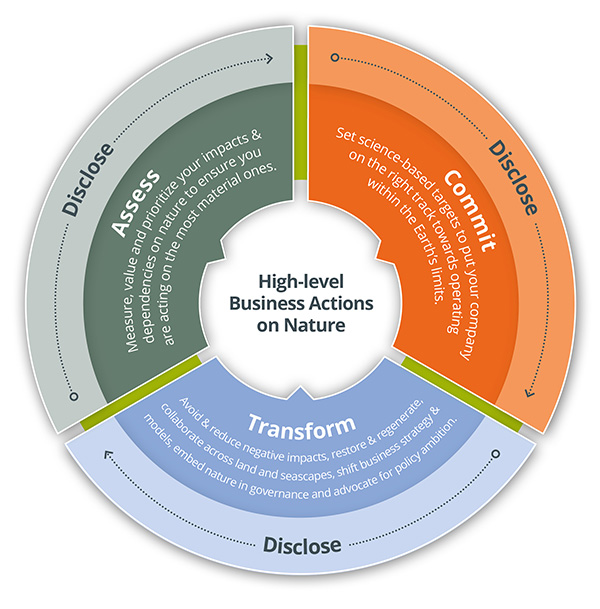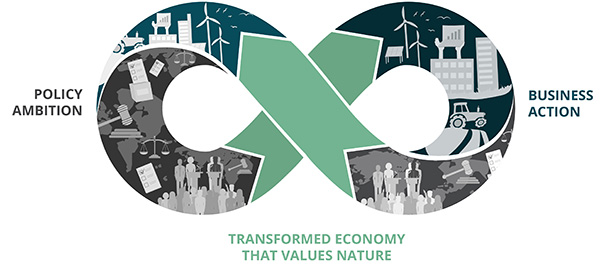AMPLIFY UPDATE VOL. 37, NO. 3

In December 2022, representatives from 196 countries came together at the United Nations Biodiversity Conference (COP15) in Montreal, Canada, to reset the world’s relationship with nature. With overwhelming support from non-state actors, they adopted the GBF — a historic agreement that established a global nature positive goal to halt and reverse nature loss by 2030.
It was nature’s “Paris moment” — but not a moment too soon. Decades of unchecked human activity have wreaked havoc on the natural world, resulting in unprecedented rates of species and ecosystem loss. Of the nine planetary boundaries within which humanity can thrive, scientists have found that six, including biosphere integrity, have been crossed. According to the World Economic Forum’s latest “Global Risks” report, two of the top four risks facing our society over the next 10 years — biodiversity loss/ecosystem collapse and natural resource shortages — are nature-related. The other two — extreme weather events and critical change to earth systems — are climate-related and would compound biodiversity loss and resource shortages (see Figure 1).

Nature underpins everything that sustains us: our livelihoods, our health, the global economy, and a livable climate. Staying on the current trajectory of nature loss jeopardizes our very survival.
Tackling the Nature & Climate Crises Together
Growing awareness of this existential threat has prioritized nature on the global agenda. There is increased recognition that the biodiversity and climate crises need to be tackled in tandem, given how closely they are interlinked. Nature-based solutions can provide a third of the climate mitigation needed. According to the Intergovernmental Panel on Climate Change (IPCC), the world’s oceans, plants, animals, and soils have absorbed half of the human-related carbon emissions over the past decade. Put simply, we cannot meet the goals of the Paris Agreement without protecting ecosystems, species, and habitats.
In Dubai, a year after COP15, nature-related discussions formed the heart of the UN Climate Change Conference (COP28). Announcements at the December 2023 event included:
-
A joint statement on climate and nature
-
Multiple commitments to protect and restore nature, with investments totaling $2.6 billion
-
A day dedicated to the food and agriculture sector, which has huge impacts on nature through land-use change and pollution
-
An expression of support for the GBF in the conference’s final outcome statement
While COP28 should have gone further on many fronts, there is no denying it marked an important step in bringing the climate and nature agendas closer.
2023 was a period of building momentum for nature, but we are still far from reaching the levels of action and funding required to secure the recovery of our planet by 2030. The “State of Finance for Nature” report, published by the UN Environment Programme (UNEP) in December 2023, found that $200 billion in financing directed at nature-based solutions in 2022 was dwarfed by $7 trillion that funded “activities directly harming nature” during that same year.
At a microeconomic level, actions and commitments to nature by businesses still lag behind their initiatives on climate. Recent research by the World Benchmarking Alliance found that only 2% of the biggest 350 companies in the global food and agriculture value chain currently disclose their impacts on the environment; none holistically address their dependencies on nature.
We urgently need to close this gap in nature action. With COP16 scheduled to take place this October in Cali, Colombia, 2024 needs to be the year when the world switches gears on nature, moving once and for all from ambition to action. Business must be front and center of this radical shift.
Businesses Stepping Up for Nature
The GBF’s targets and goals place the private sector at the center of an all-encompassing approach. In particular, Target 15 calls for businesses to “assess, disclose, and reduce” biodiversity-related risks and negative impacts, sending a clear message that corporate action will be mandated, with companies and large institutions told to get ready to disclose their risks, impacts, and dependencies on nature by 2030. This was the first explicit articulation of action by business on nature in a multilateral agreement.
The shift toward models that restore nature, rather than destroy it, is in the interest of business. More than half of the global GDP, $58 trillion, is dependent on nature, and some economic sectors (including food, agriculture, and construction) are entirely reliant on ecosystem services. Although we have taken it for granted and failed to account for it in balance sheets, natural capital is a fundamental asset to business. In fact, research shows that actions such as switching to regenerative agriculture, tackling food waste, and reducing the use of plastic can positively impact the bottom line.
A growing number of companies understand that the risks they are exposed to through nature loss need to be mitigated, from disrupted value chains to shifting regulatory and consumer demands. And many have started advocating for nature. The private sector has been stepping up, with business-led advocacy campaigns, unprecedented numbers of corporations attending COPs to support ambitious outcomes, and nature-specific commitments from companies and investors.
This is encouraging, but what we now need is nothing short of a sea change, with businesses of all sizes and sectors contributing to a transformation of our socioeconomic systems. Breaking away from decades of a model based on the overexploitation of nature may seem daunting, but research, best practices, and guidance are becoming increasingly available to help individual companies either kickstart or accelerate their nature strategies and catalyze a rapid transition to a nature positive economy.
Guiding Corporate Action on Nature
Over the last few years, several initiatives have been launched, piloted, and refined to give business leaders the tools to embed nature in their operations and throughout their value chains. These include an action framework from the Science-based Targets Network (SBTN), the World Business Council for Sustainable Development (WBCSD) “Roadmaps to Nature Positive,” and the disclosure recommendations from the Taskforce on Nature-related Financial Disclosures (TNFD).
The Business for Nature coalition has worked with supportive partners and companies and has consolidated many of these guidelines and frameworks into a set of high-level business actions: assess, commit, transform, and disclose (see Figure 2). Often referred to as “ACT-D,” these actions provide a structured approach to help companies credibly embed nature in their decision-making, minimize their impacts, and contribute to the transformation of our economic and financial systems. Businesses need to:
-
Assess and measure their impacts and dependencies on nature.
-
Set transparent, time-bound, science-based targets.
-
Take actions to address their key impacts and dependencies.
-
Publicly disclose performance and other relevant nature-related information.

Forward-looking companies have started taking these actions and influencing public policy to try and bring about broader system-level change. An encouraging sign of this shift is the number of companies that have registered as Early Adopters of the TNFD’s recommendations on disclosure and reporting.
This progressive mindset now needs to become the norm. The ACT-D framework can help drive change — at both the company and sector level.
Transitioning to a Nature Positive Economy, Sector by Sector
For any business, meaningful action on nature needs to start by understanding its current interactions with ecosystems in order to reduce its negative impacts and increase the positive ones. Given that each sector of the economy has specific impacts and dependencies on nature, using a sectoral lens is critical in determining a company’s most effective steps and identifying opportunities for collaboration across value chains.
To support this evaluation, Business for Nature, WBCSD, and the World Economic Forum launched guidance for 12 global sectors: agrifood, built environment, chemicals, construction materials (cement/concrete), energy, fashion and apparel, financial services, forest products, household/personal care products, travel and tourism, waste management, and water utilities/services.
This resource offers companies sector-specific actions and draws on input from a wide range of corporate leaders, academics, nongovernmental organizations, and government experts. It highlights each sector’s impacts and dependencies on nature and uses tailored best practices to give business leaders practical recommendations aligned with high-level business actions.
Some examples of sector-specific, high-impact actions include:
-
Energy businesses adopting circular designs and incorporating recycled materials in turbines
-
Household and personal care product companies increasing investment in nature-conscious products and business models, such as refillable products, waterless formulations, and reusable or durable products to minimize water consumption and water pollution
-
Cement and concrete businesses replacing fresh water with harvested rainwater or treated municipal water, establishing water recycling systems, and creating artificial wetlands to reduce withdrawal and improve water quality
-
Agrifood companies committing to and implementing deforestation to accelerate the regeneration of land and ecosystems, adopting conversion-free production and/or sourcing, and supporting farmers who embed regenerative agricultural practices
Developing & Publishing Credible Nature Strategies
With this sector-specific framework available to guide their decisions, business leaders can develop a nature strategy for their organization, either as part of their existing sustainability plans or as targeted approaches to address material nature issues. Because the stakes are so high, all businesses need to commit to the nature positive transition and inspire each other through visible, accountable action.
To support the transition, Business for Nature launched “It’s Now for Nature,” a joint global campaign inviting all companies to develop and share their nature strategies. The campaign provides both a practical guide (“The Nature Strategy Handbook”) to help build or improve nature strategies using the ACT-D framework and an online platform for publishing those plans.
COP16 is on the horizon as the next global milestone for assessing and accelerating the implementation of the GBF, making it necessary to gather a wide-ranging set of corporate nature strategies to showcase how business is taking action.
Advocating for Ambitious Policy
In addition to transforming their direct operations and reshaping sector value chains, businesses play a crucial role in influencing policies and regulations at industry, national, and international levels. Rewriting our global economy’s rulebook is essential in enabling business and finance to take action at the pace science demands. Indeed, the private sector’s support and encouragement of government action is instrumental in implementing the GBF. Business and political leadership needs to collaborate if we are to reverse decades of subsidies and incentives that have driven the degradation of our natural world.
Business for Nature has prepared a Responsible Policy Engagement (RPE) guide to help businesses step up in the political landscape and voice support for public policies that will unlock investment and create a regulatory environment that delivers action at scale (see Figure 3).

Responsible advocacy should be a key element of any corporate nature strategy and a vital tool in helping companies respond to growing stakeholder expectations. Businesses should continue to embolden governments to embrace ambitious policies, legislations, and regulations at the global, regional, national, and local levels.
Building a Nature Positive Future
We’re at a critical point on the road to a nature positive future. We now fully understand the extent to which our current economic model affects nature and how it is driving us toward dangerous and potentially irreversible consequences. We know the scale of the change we need to make. We have agreed on the goal. And we now have a roadmap to get there.
Thanks to available tools and leadership from pioneering companies, every business can join the collective shift to an equitable, nature positive future. This must be the year when enough is done for the world to change course before it is too late.



